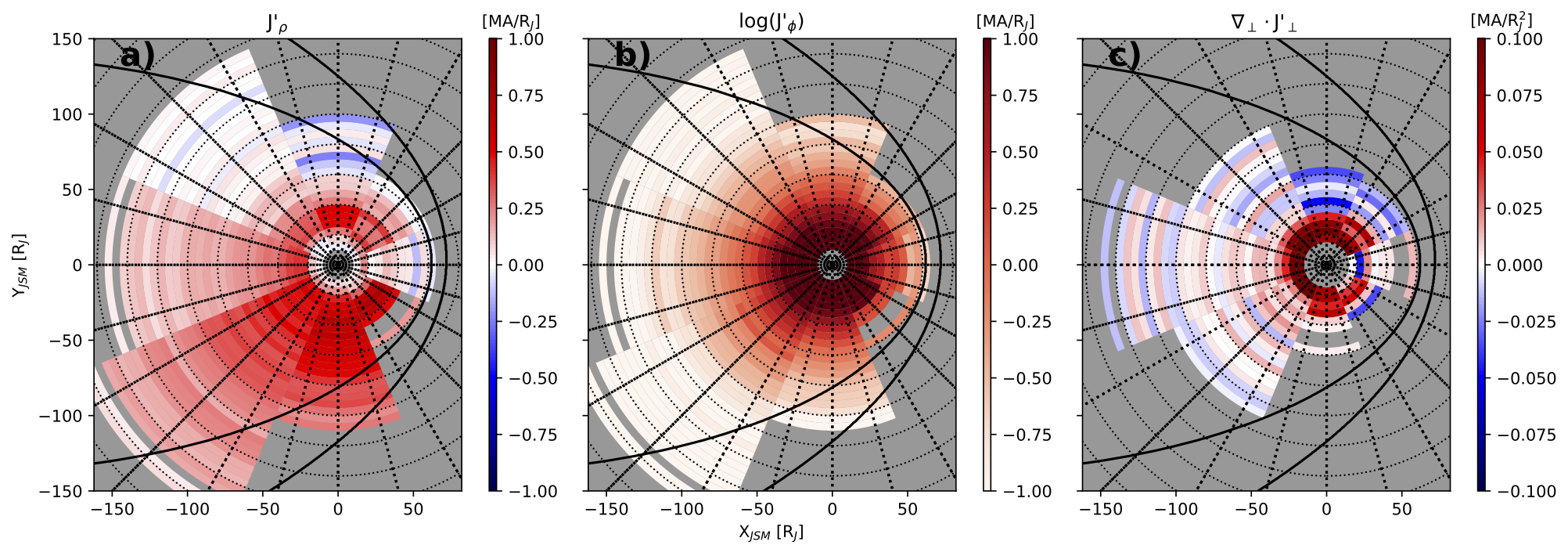MIST
Magnetosphere, Ionosphere and Solar-Terrestrial
Local Time Asymmetries in Jupiter's Magnetodisc Currents
By Chris Lorch (Lancaster University)
Jupiter’s large, rapidly rotating magnetosphere is highly influenced by the presence of a global, centrifugally confined current disk comprised of co-rotating plasma from the volcanic moon Io. Azimuthal and radial currents flow through this current disk closing via magnetic field aligned currents (FACs), which are associated with Jupiter’s main auroral emission. These currents arise from dynamical processes within the magnetosphere, driven by the transport and circulation of Iogenic plasma. Characterising the structure and asymmetries in this current system is key to deciphering the dominant drivers of Jupiter’s magnetosphere-ionosphere (MI) coupled system and the behaviour of its plasma disk.
Previous work by Khurana [2001] examined the solar wind influence on Jupiter’s magnetosphere using equatorial maps of Jupiter’s current disk and the results demonstrated clear azimuthal asymmetries fixed with local time (LT). However, the analysis was limited the lack of spacecraft coverage in the dusk – dayside magnetosphere provided by the Galileo spacecraft.

Figure 1: Equatorial maps detailing the structure of Jupiter’s current disk with Jupiter located at (0,0). Dashed circles and radial lines represent 20RJ and 1 hr local time boundaries respectively. A compressed bow shock and magnetopause (Joy et al [2002]) are shown as black solid lines. a) The radial height-integrated current density, warmer (cooler) colours are indicative of current flowing radially outwards (inwards). b) The azimuthal height integrated colour density, flowing in the direction of corotation. c) The divergence of the perpendicular height-integrated current density, indicating the location of upward and downward FACs. Warmer (cooler) colours indicate the presence of upward (downward) FACs.
Lorch et al. [2020] determines the structure of the current disk at all LTs by considering magnetometer data at Jupiter from every available spacecraft, including Juno, up to 28 July 2018. We apply an automated identification tool to magnetometer data from Jupiter’s current disk in conjunction with updated models of Jupiter’s intrinsic magnetic field and current disk geometry. In total, we identify 7382 lobe traversals, calculating the associated height-integrated current density for each crossing. Additional coverage provided by the later half of the Galileo mission and the recent Juno mission allowed us to map all LTs. Asymmetries exist in both the radial (Figure 1a) and azimuthal (Figure 1b) currents into 20 RJ. Furthermore, we quantify the structure of upward and downward FACs in previously unmapped regions of Jupiter’s magnetosphere (Figure 1c). We find a positive net current density of 1.87 MA / RJ2, suggesting unmapped currents must close either down-tail or along the magnetopause. Our results demonstrate important asymmetries in Jupiter’s current systems that play a crucial role in the MI coupled system. Amalgamating these results into future MI coupling models has the potential to remove discrepancies between model predictions and observations.
For more information, please see the paper:
Lorch, C. T. S., Ray, L. C., Arridge, C. S., Khurana, K. K., Martin, C. J., & Bader, A. (2020). Local time asymmetries in Jupiter's magnetodisc currents. Journal of Geophysical Research: Space Physics, 125, e2019JA027455. https://doi.org/10.1029/2019JA027455